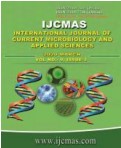


 National Academy of Agricultural Sciences (NAAS)
National Academy of Agricultural Sciences (NAAS)

|
PRINT ISSN : 2319-7692
Online ISSN : 2319-7706 Issues : 12 per year Publisher : Excellent Publishers Email : editorijcmas@gmail.com / submit@ijcmas.com Editor-in-chief: Dr.M.Prakash Index Copernicus ICV 2018: 95.39 NAAS RATING 2020: 5.38 |
Gonorrhoea is a sexually transmitted infection caused by Neisseria gonorrhoeae and is a major public health problem. Resistance has rapidly emerged to recommended antimicrobial agents for the management of gonorrhoea. This study was undertaken to determine the resistance of Neisseria gonorrhoeae among t he clinically suspected cases of gonorrhoea in an STD Referral Centre. Urethral discharge and endocervical swabs were collected from clinically suspected cases of gonorrhoea. Gram’s stain was performed to observe intracellular gram-negative diplococci. Blood agar and Chocolate agar were used for the growth of the organism. Antibiotic sensitivity testing was performed by the Kirby Bauer technique using the Calibrated Dichotomous Sensitivity method and CLSI method. Chromogenic cephalosporin test was done to identify Penicillinase Producing Neisseria gonorrhoea. Results: 3213 patients attended the STD Out Patient Department during the study period. From clinically suspected cases of gonorrhoea, 66 urethral discharge and 2 endocervical samples were collected. 17 (25%) samples were positive for Neisseria gonorrhoea out of which eight were Penicillinase Producing Neisseria gonorrhoea. Neisseria gonorrhoeae was resistant to penicillin, ciprofloxacin and nalidixic acid. The results of our study demonstrated a sharp increase in the percentage of PPNG in India over the past two decades. Hence, studying the resistance patterns of gonorrhoea and identification of PPNG strains will greatly help with prescribing the most appropriate antimicrobials for the effective treatment of gonorrhoea.
 |
 |
 |
 |
 |